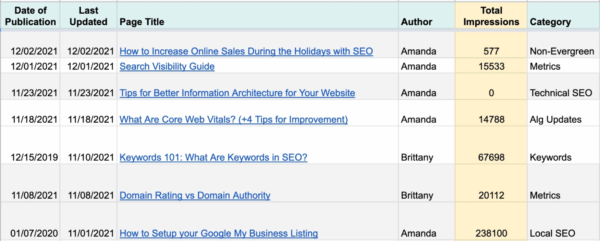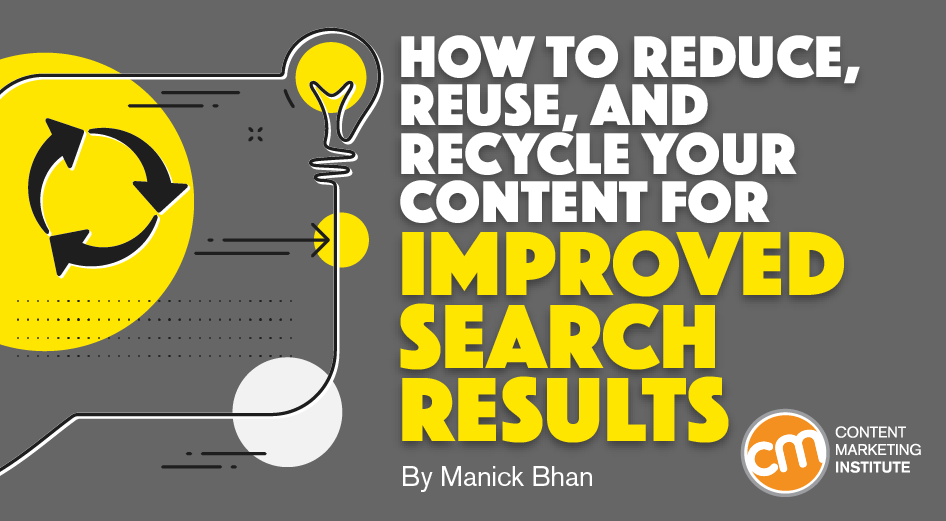You’re likely familiar with the reduce, reuse, recycle model of waste management, but have you considered it for your search-focused content?
Follow the 3R approach by pruning and revising your site’s content regularly. That strategy can help snip the content weighing down your site’s overall search engine result page (SERP) rankings.
Let’s get started.
Think about using the reduce, reuse, recycle model of waste management as a #content audit strategy, says @madmanick via @CMIContent. #SEO Click To TweetCreate a content inventory
You must know what content exists. If you have a spreadsheet or other tracker detailing your content assets, skip to step two. If not, it’s time to create one. For each asset, include:
- URL (our team links each page to its title)
- Title
- Author
- Post date
- Updated date
- Category (if applicable)
- Total impressions

The benefits of pruning include:
- Ensuring high-performing, high-converting pages get indexed
- Helping prevent keyword cannibalization, duplicate content, and other content setbacks
- Removing outdated content to improve your site’s user experience
Now you can move to the reduce, reuse, and recycle steps. You’ll give each page a score. We added a column on the inventory spreadsheet – pruning audit – to include a score on a scale of one to four:

In this scale:
- One – Content should be removed to reduce excess and unnecessary pages. The content can’t be recycled in another format or location. The URL should be redirected to avoid broken links.
- Two – Content should be recycled and the page redirected.
- Three – Content and URL should be reused but reoptimized.
- Four – No changes are necessary.
Reduce
Think of this as spring cleaning for your website. You’ll likely spend the most time on the reduced portion of the model. This stage involves content pruning – trimming away blogs, landing pages, and other pages that aren’t earning the organic traffic they were created to attract. You can do one of two typical ways:
- Remove the page from the site or
- No index the page, so Google’s web crawlers won’t even look at it.
Eliminate any duplicate content as it could prompt Google to penalize your site. A site content audit tool can make quick work of identifying these pages.
Spring cleaning tip for #content marketers: Trim away blogs, landing pages, and others that don’t earn the organic traffic they were created to attract, says @madmanick via @CMIContent. #SEO Click To TweetAt my company, we use our tool to identify duplicate pages. It includes a breakdown that shows the duplicate content distribution by pages, title tags, H1 tags, descriptions, and content. From there, we drill down to the individual pages.

When you find duplicate content, remove the URL from your site and redirect to the preferred page. Canonicalization errors can also result in duplicate content errors, which can be repaired by employing canonical tags.
Next, assess which pages deserve closer inspection for reduction consideration. Run a report in Google Search Console or other rank-tracking software. We used the Search Atlas Site Audit Page Pruning tool to make identifying underperforming pages easy with a red dot. Highlight the dot to discover the URL, audit metrics, etc.

HANDPICKED RELATED CONTENT:
Reuse
You can reuse the content that earned a three on the inventory scorecard so it can shine once again. Take a closer look at your metrics to determine the best reoptimization approach.
Look for pages that had steady traffic but saw a slow or sharp drop in performance. These decaying pages often have great content that can be reused for improved performance – reoptimized using the same URL.
Exception: If a decaying page covers a timely topic that is no longer relevant, rate it a two and consider recycling it and using a URL redirect.
For content with high impressions in search results but low traffic, update your meta tags – title, description, or URL.
For pages with high bounce rates, look at the headings and overall structure. If these don’t follow best practices, fix them. If they adhere to them, consider adding more content to turn an ordinary piece into one with impressive topical depth. Build individual sections and be mindful of including semantically related terms.
HANDPICKED RELATED CONTENT:
Recycle
Now, look for pages that are stagnant or underperform and never did well in search ranking results. You can recycle this content on better-performing pages targeting semantically related keywords.

This is where the magic happens – where you repurpose the content through merging or more creative alternatives. Here are some options:
- Merge pages: When two pages compete for the same keyword in search results, cannibalization occurs and Google gets confused. Your preferred page for searchers to find is ranked lower and essentially hidden. To fix this with the reuse approach, merge the less popular page’s content with the better-performing one.
TIP: Unsure if you have keyword cannibalization? Enter your domain + the keyword. If your less-preferred page appears higher, you have an issue.
- Use it in other content types: For example, content on a page about gift ideas that performed well during the holidays but no longer gets traffic can be set aside for next year’s holiday email campaign. Or you could repurpose it into a blog about birthday gifts.
- Repurpose as a guest blog post: If the content is a blog article, it could be an excellent candidate for another website. That holiday gift article, for example, could be a good guest post on a shopping blog.
Practice 3Rs regularly
Reduce, reuse, and recycle isn’t a one-time event. It should be ingrained into your content lifecycle. Continue to use a critical eye when planning your content and check your site’s health regularly, performing a large-scale pruning quarterly.
All tools mentioned in the article are identified by the author. If you have a tool to suggest, please feel free to add it in the comments.
Cover image by Joseph Kalinowski/Content Marketing Institute

